UGB 163: Introduction to Accounting and Finance Report
VerifiedAdded on 2023/01/18
|21
|3532
|58
Report
AI Summary
This comprehensive report analyzes the financial performance of three companies: Terry Joe Plc, Kokolet Limited, and Smith Howe Limited. Part A focuses on Terry Joe Plc, presenting its statement of income and statement of financial position for its first year of trading. Part B delves into Kokolet Limited, examining contribution margins, break-even analysis, margin of safety, and profit calculations under various scenarios, along with an exploration of the assumptions underpinning the break-even model. Part C evaluates Smith Howe Limited, applying investment appraisal techniques such as payback period, accounting rate of return, and net present value to a machine investment, followed by a discussion of the merits and limitations of these techniques and a review of the benefits and limitations of budgeting for strategic planning. The report aims to provide a detailed understanding of financial accounting, management accounting, and investment analysis.
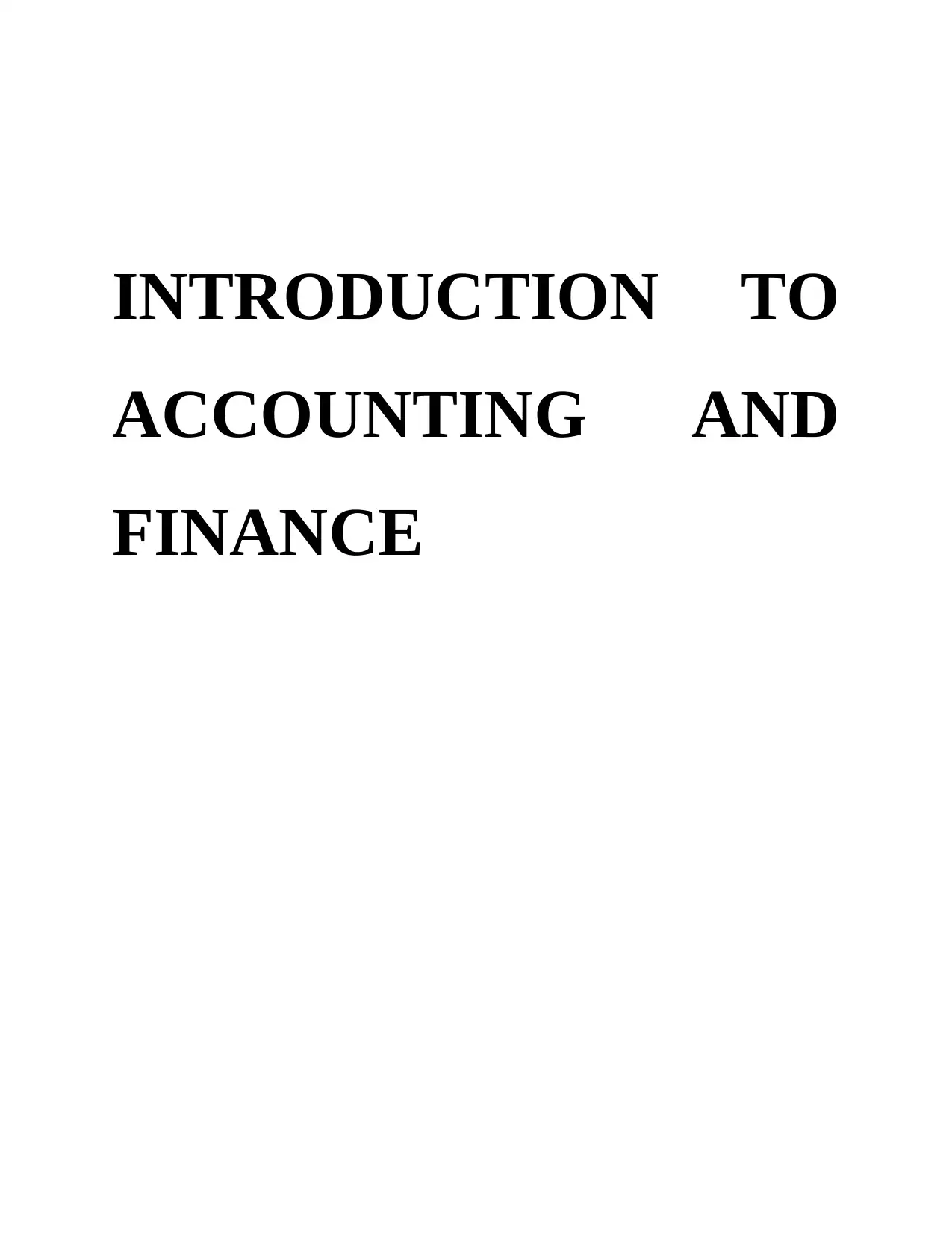
INTRODUCTION TO
ACCOUNTING AND
FINANCE
ACCOUNTING AND
FINANCE
Paraphrase This Document
Need a fresh take? Get an instant paraphrase of this document with our AI Paraphraser
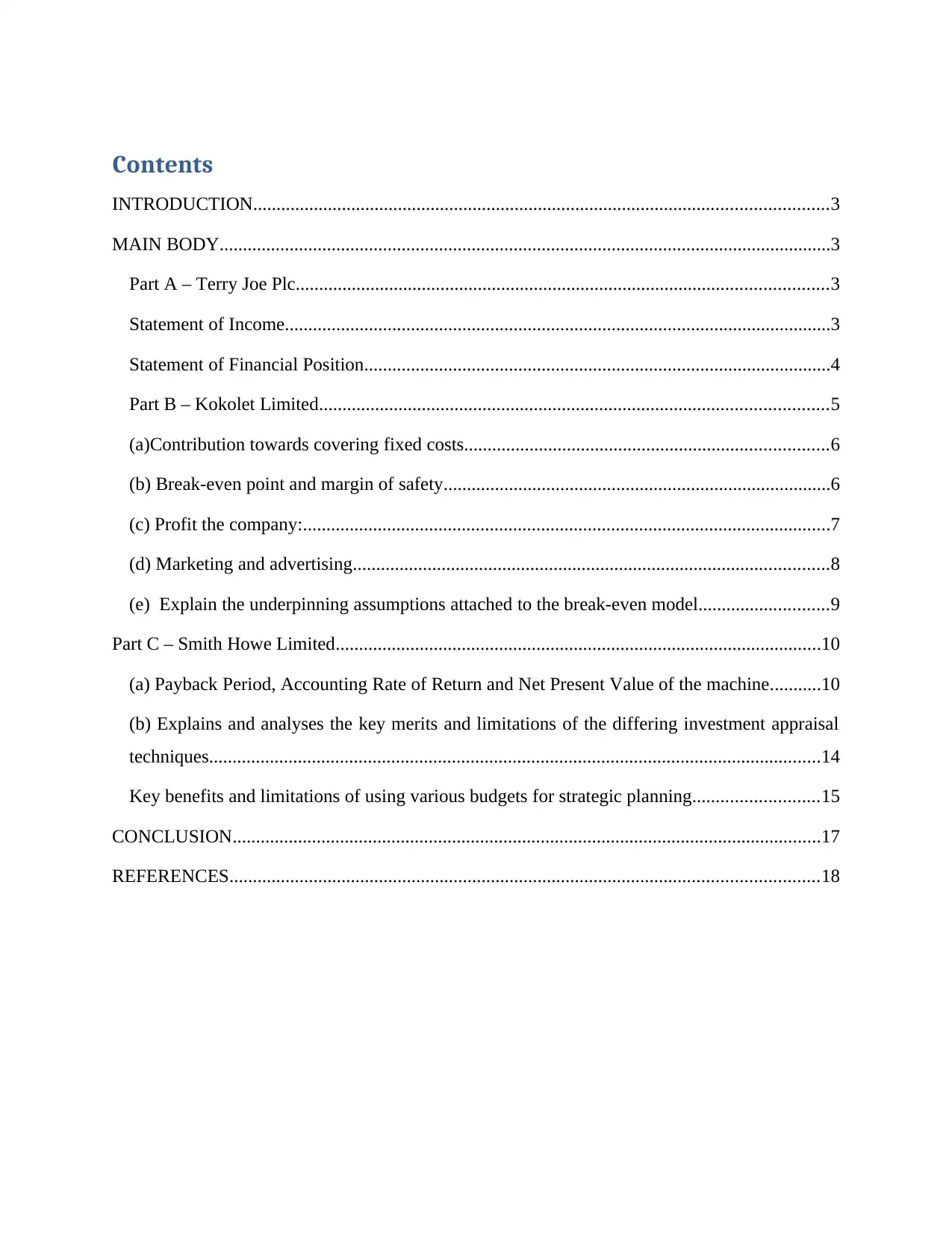
Contents
INTRODUCTION...........................................................................................................................3
MAIN BODY...................................................................................................................................3
Part A – Terry Joe Plc..................................................................................................................3
Statement of Income.....................................................................................................................3
Statement of Financial Position....................................................................................................4
Part B – Kokolet Limited.............................................................................................................5
(a)Contribution towards covering fixed costs..............................................................................6
(b) Break-even point and margin of safety...................................................................................6
(c) Profit the company:.................................................................................................................7
(d) Marketing and advertising......................................................................................................8
(e) Explain the underpinning assumptions attached to the break-even model............................9
Part C – Smith Howe Limited........................................................................................................10
(a) Payback Period, Accounting Rate of Return and Net Present Value of the machine...........10
(b) Explains and analyses the key merits and limitations of the differing investment appraisal
techniques...................................................................................................................................14
Key benefits and limitations of using various budgets for strategic planning...........................15
CONCLUSION..............................................................................................................................17
REFERENCES..............................................................................................................................18
INTRODUCTION...........................................................................................................................3
MAIN BODY...................................................................................................................................3
Part A – Terry Joe Plc..................................................................................................................3
Statement of Income.....................................................................................................................3
Statement of Financial Position....................................................................................................4
Part B – Kokolet Limited.............................................................................................................5
(a)Contribution towards covering fixed costs..............................................................................6
(b) Break-even point and margin of safety...................................................................................6
(c) Profit the company:.................................................................................................................7
(d) Marketing and advertising......................................................................................................8
(e) Explain the underpinning assumptions attached to the break-even model............................9
Part C – Smith Howe Limited........................................................................................................10
(a) Payback Period, Accounting Rate of Return and Net Present Value of the machine...........10
(b) Explains and analyses the key merits and limitations of the differing investment appraisal
techniques...................................................................................................................................14
Key benefits and limitations of using various budgets for strategic planning...........................15
CONCLUSION..............................................................................................................................17
REFERENCES..............................................................................................................................18

INTRODUCTION
Accounting is a tool of assessing business activities, converting information into reports
and delivering results to decision makers (Shah, 2013). Indeed, the financial statements are the
main documents that communicate with the full perspectives on the financial performance of the
corporation. The primary role of accounting in businesses is also linked to the identification of
fragile business sectors. Business executives must describe business objectives, track progress
and take appropriate measures if the expected action to take is not favorable. Some decisions,
such as purchasing supplies, managing stocks, investing, etc., include financial reporting details.
It helps managers to make better policies enhance the overall company future performance. The
report consist information about analysis of financial position and revenue is included in this
document on the basis of given data in brief. As well as BEP analysis is also calculated and in
further part of project report, payback period, accounting rate of return and net present value is
applied on given value of assets.
MAIN BODY
Part A – Terry Joe Plc
Profit and loss account- A profit and loss statement shows the profits and expenditures of a
corporation over a specified period of time, generally one quarter or a calculated period of a year
(Chiang, Nouri and Samanta, 2014). Those statistics show that the business has made a profit or
a loss over that amount of time.
Statement of Income
It is important and essential part of financial statement which is used by an organization
in order to reporting their financial performance and success over a particular accounting time
period. The income statement of any organization is emphasis on four items which are expenses,
revenues, losses and gains.
Income statement for the year 31st December 2018
Accounting is a tool of assessing business activities, converting information into reports
and delivering results to decision makers (Shah, 2013). Indeed, the financial statements are the
main documents that communicate with the full perspectives on the financial performance of the
corporation. The primary role of accounting in businesses is also linked to the identification of
fragile business sectors. Business executives must describe business objectives, track progress
and take appropriate measures if the expected action to take is not favorable. Some decisions,
such as purchasing supplies, managing stocks, investing, etc., include financial reporting details.
It helps managers to make better policies enhance the overall company future performance. The
report consist information about analysis of financial position and revenue is included in this
document on the basis of given data in brief. As well as BEP analysis is also calculated and in
further part of project report, payback period, accounting rate of return and net present value is
applied on given value of assets.
MAIN BODY
Part A – Terry Joe Plc
Profit and loss account- A profit and loss statement shows the profits and expenditures of a
corporation over a specified period of time, generally one quarter or a calculated period of a year
(Chiang, Nouri and Samanta, 2014). Those statistics show that the business has made a profit or
a loss over that amount of time.
Statement of Income
It is important and essential part of financial statement which is used by an organization
in order to reporting their financial performance and success over a particular accounting time
period. The income statement of any organization is emphasis on four items which are expenses,
revenues, losses and gains.
Income statement for the year 31st December 2018
⊘ This is a preview!⊘
Do you want full access?
Subscribe today to unlock all pages.

Trusted by 1+ million students worldwide
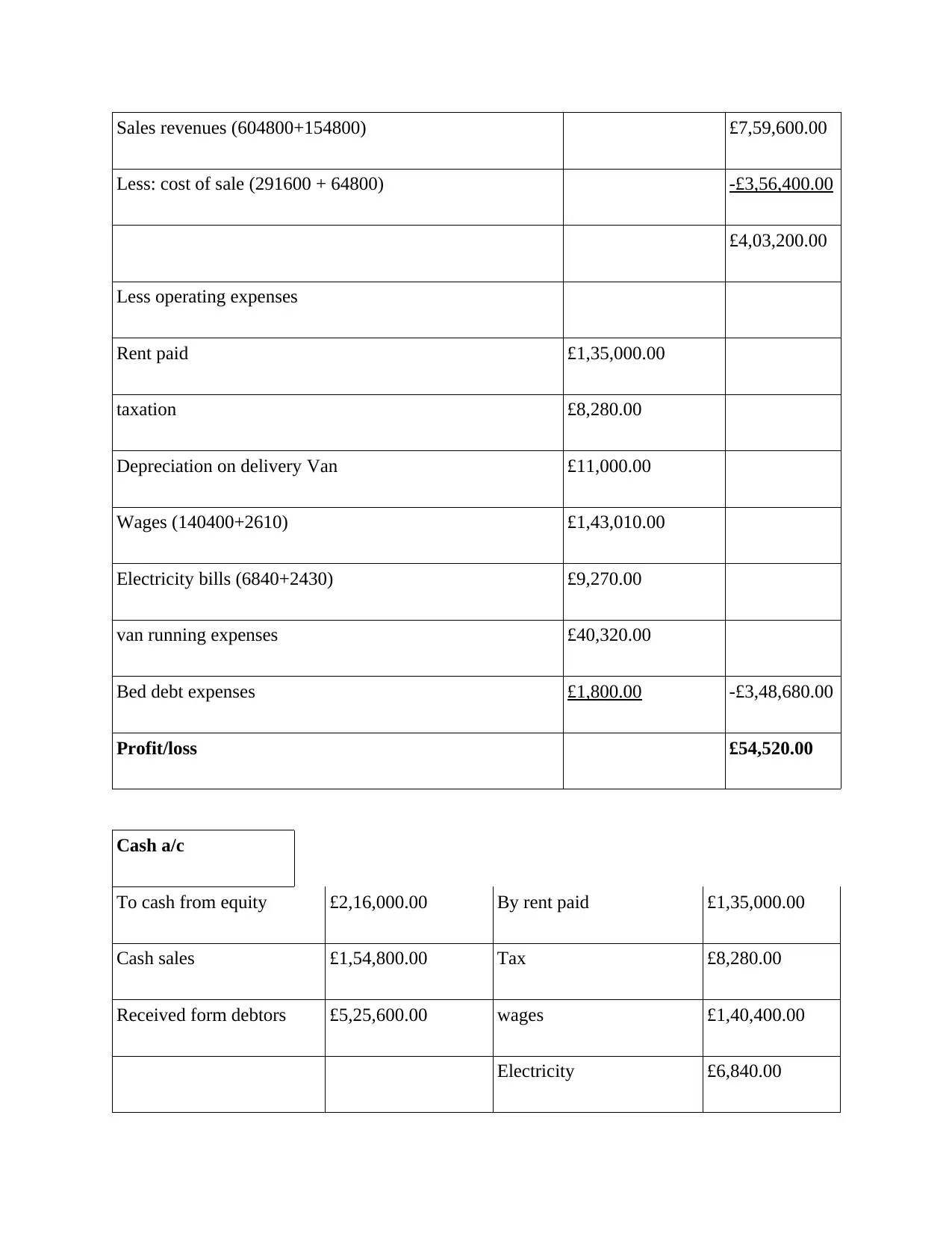
Sales revenues (604800+154800) £7,59,600.00
Less: cost of sale (291600 + 64800) -£3,56,400.00
£4,03,200.00
Less operating expenses
Rent paid £1,35,000.00
taxation £8,280.00
Depreciation on delivery Van £11,000.00
Wages (140400+2610) £1,43,010.00
Electricity bills (6840+2430) £9,270.00
van running expenses £40,320.00
Bed debt expenses £1,800.00 -£3,48,680.00
Profit/loss £54,520.00
Cash a/c
To cash from equity £2,16,000.00 By rent paid £1,35,000.00
Cash sales £1,54,800.00 Tax £8,280.00
Received form debtors £5,25,600.00 wages £1,40,400.00
Electricity £6,840.00
Less: cost of sale (291600 + 64800) -£3,56,400.00
£4,03,200.00
Less operating expenses
Rent paid £1,35,000.00
taxation £8,280.00
Depreciation on delivery Van £11,000.00
Wages (140400+2610) £1,43,010.00
Electricity bills (6840+2430) £9,270.00
van running expenses £40,320.00
Bed debt expenses £1,800.00 -£3,48,680.00
Profit/loss £54,520.00
Cash a/c
To cash from equity £2,16,000.00 By rent paid £1,35,000.00
Cash sales £1,54,800.00 Tax £8,280.00
Received form debtors £5,25,600.00 wages £1,40,400.00
Electricity £6,840.00
Paraphrase This Document
Need a fresh take? Get an instant paraphrase of this document with our AI Paraphraser
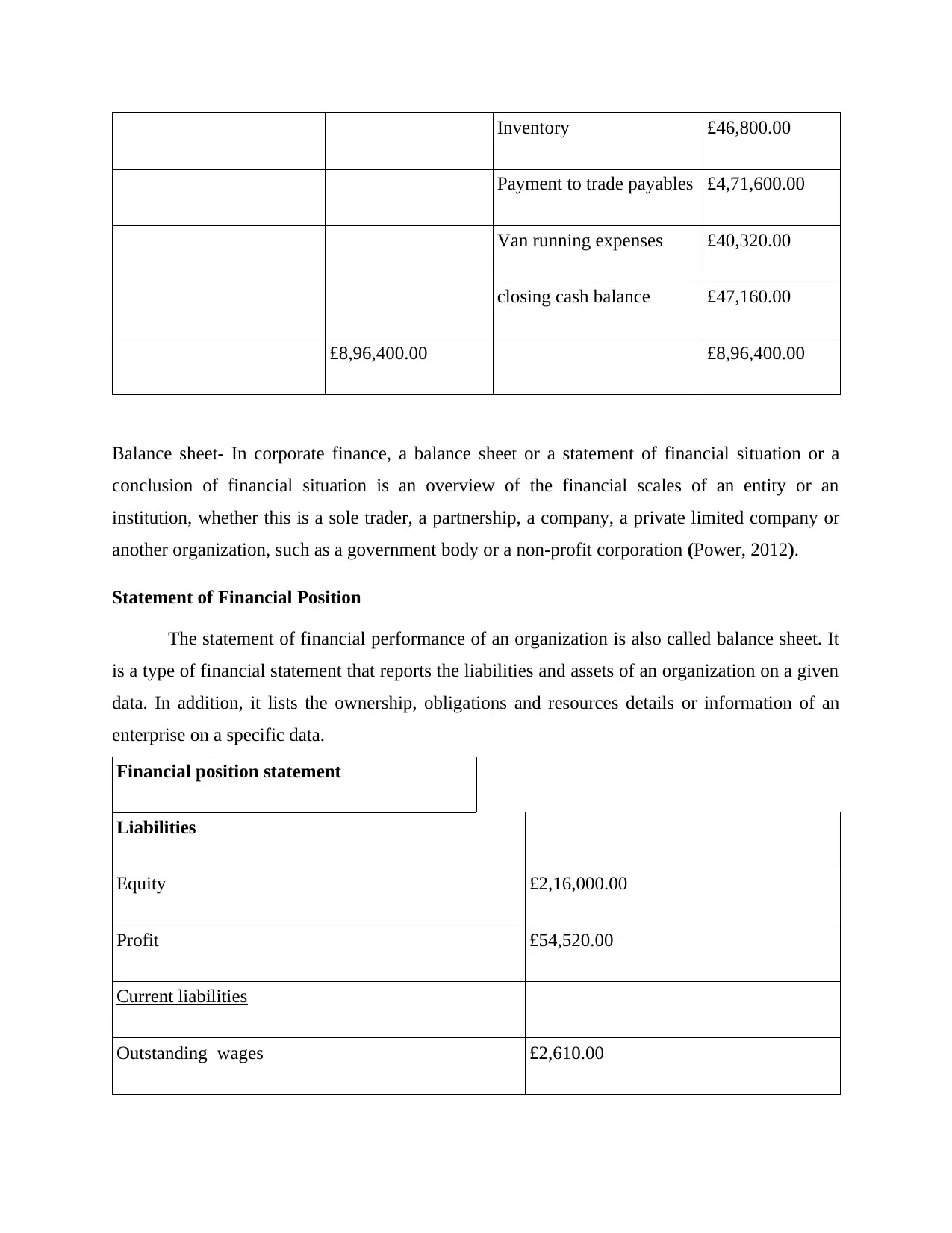
Inventory £46,800.00
Payment to trade payables £4,71,600.00
Van running expenses £40,320.00
closing cash balance £47,160.00
£8,96,400.00 £8,96,400.00
Balance sheet- In corporate finance, a balance sheet or a statement of financial situation or a
conclusion of financial situation is an overview of the financial scales of an entity or an
institution, whether this is a sole trader, a partnership, a company, a private limited company or
another organization, such as a government body or a non-profit corporation (Power, 2012).
Statement of Financial Position
The statement of financial performance of an organization is also called balance sheet. It
is a type of financial statement that reports the liabilities and assets of an organization on a given
data. In addition, it lists the ownership, obligations and resources details or information of an
enterprise on a specific data.
Financial position statement
Liabilities
Equity £2,16,000.00
Profit £54,520.00
Current liabilities
Outstanding wages £2,610.00
Payment to trade payables £4,71,600.00
Van running expenses £40,320.00
closing cash balance £47,160.00
£8,96,400.00 £8,96,400.00
Balance sheet- In corporate finance, a balance sheet or a statement of financial situation or a
conclusion of financial situation is an overview of the financial scales of an entity or an
institution, whether this is a sole trader, a partnership, a company, a private limited company or
another organization, such as a government body or a non-profit corporation (Power, 2012).
Statement of Financial Position
The statement of financial performance of an organization is also called balance sheet. It
is a type of financial statement that reports the liabilities and assets of an organization on a given
data. In addition, it lists the ownership, obligations and resources details or information of an
enterprise on a specific data.
Financial position statement
Liabilities
Equity £2,16,000.00
Profit £54,520.00
Current liabilities
Outstanding wages £2,610.00
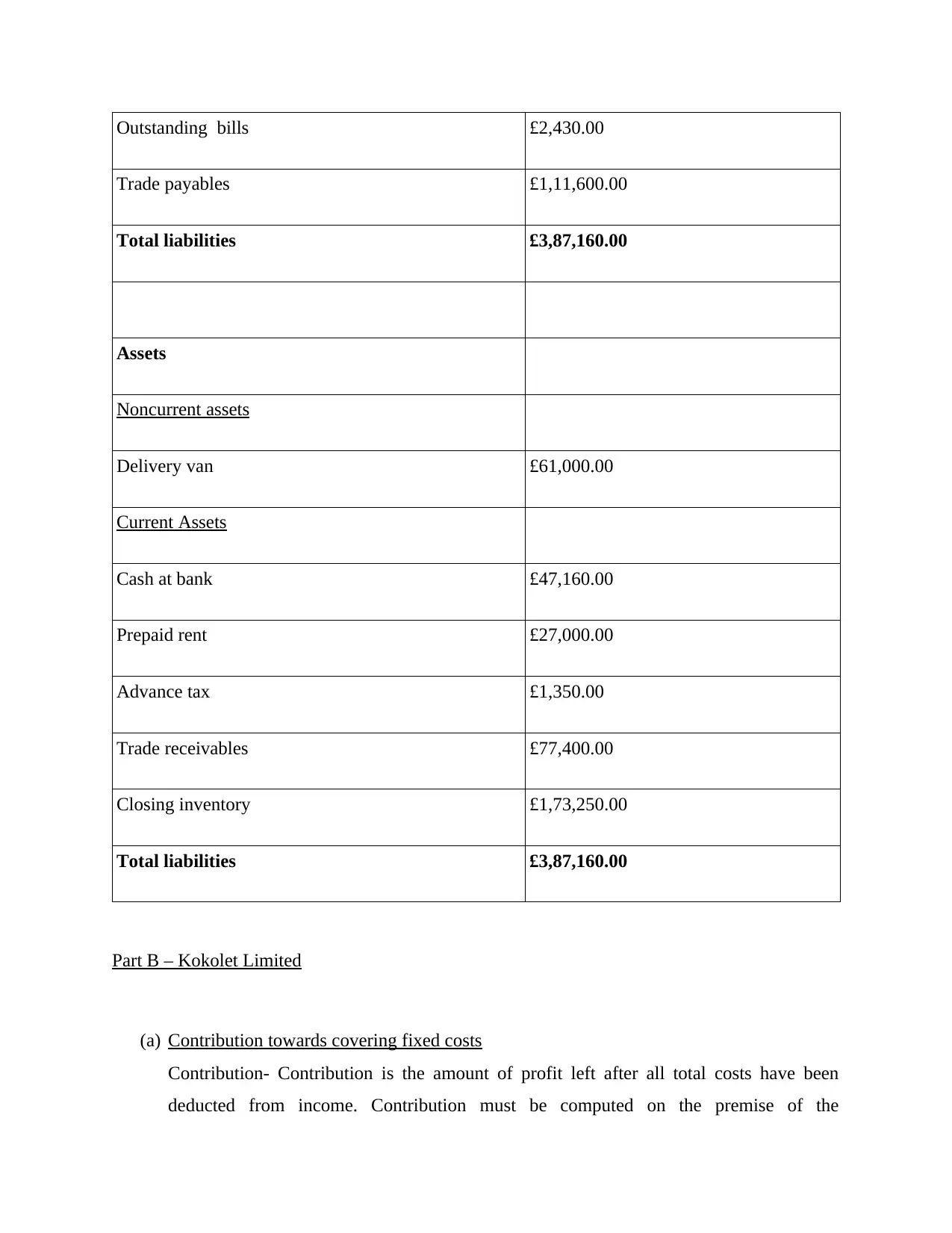
Outstanding bills £2,430.00
Trade payables £1,11,600.00
Total liabilities £3,87,160.00
Assets
Noncurrent assets
Delivery van £61,000.00
Current Assets
Cash at bank £47,160.00
Prepaid rent £27,000.00
Advance tax £1,350.00
Trade receivables £77,400.00
Closing inventory £1,73,250.00
Total liabilities £3,87,160.00
Part B – Kokolet Limited
(a) Contribution towards covering fixed costs
Contribution- Contribution is the amount of profit left after all total costs have been
deducted from income. Contribution must be computed on the premise of the
Trade payables £1,11,600.00
Total liabilities £3,87,160.00
Assets
Noncurrent assets
Delivery van £61,000.00
Current Assets
Cash at bank £47,160.00
Prepaid rent £27,000.00
Advance tax £1,350.00
Trade receivables £77,400.00
Closing inventory £1,73,250.00
Total liabilities £3,87,160.00
Part B – Kokolet Limited
(a) Contribution towards covering fixed costs
Contribution- Contribution is the amount of profit left after all total costs have been
deducted from income. Contribution must be computed on the premise of the
⊘ This is a preview!⊘
Do you want full access?
Subscribe today to unlock all pages.

Trusted by 1+ million students worldwide
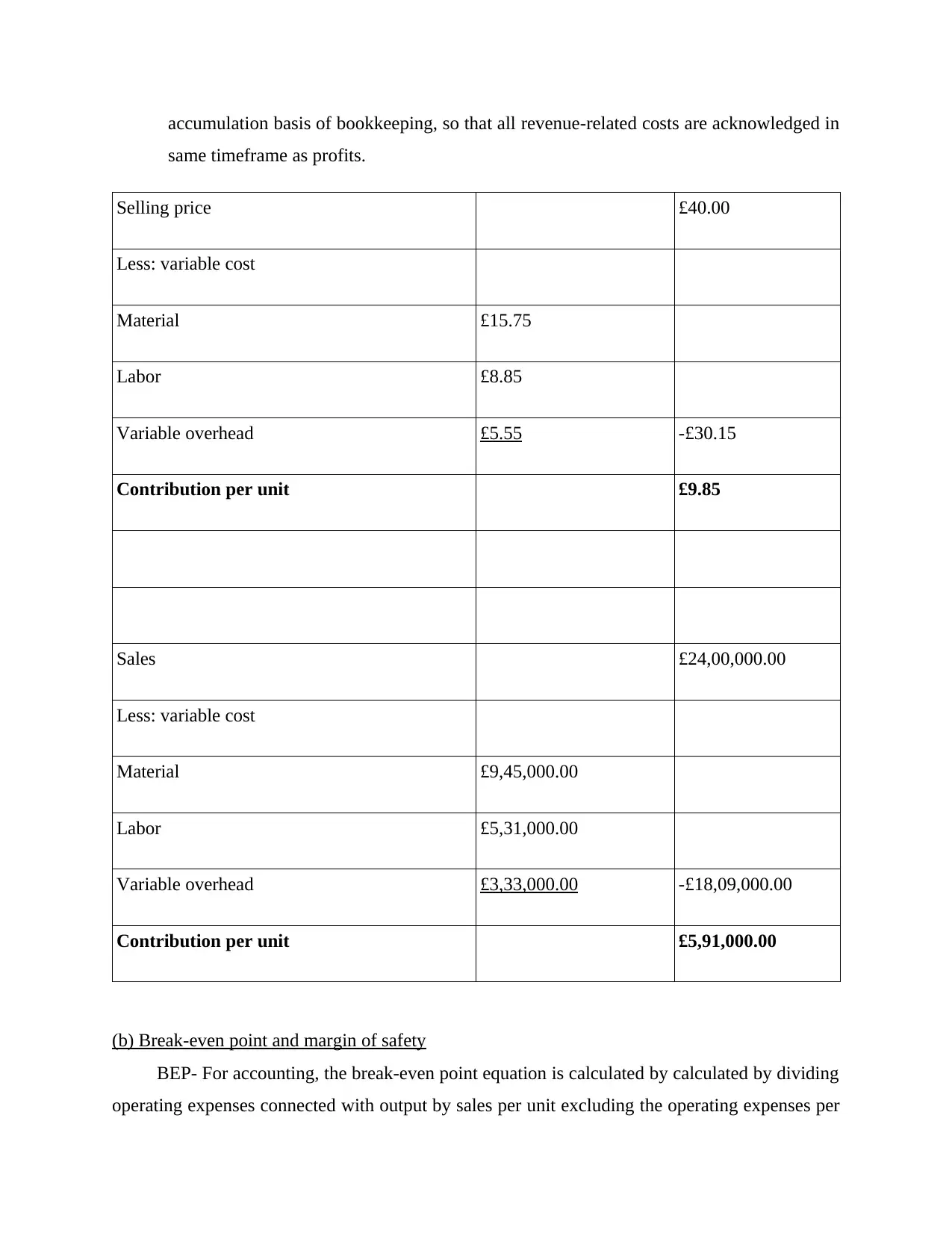
accumulation basis of bookkeeping, so that all revenue-related costs are acknowledged in
same timeframe as profits.
Selling price £40.00
Less: variable cost
Material £15.75
Labor £8.85
Variable overhead £5.55 -£30.15
Contribution per unit £9.85
Sales £24,00,000.00
Less: variable cost
Material £9,45,000.00
Labor £5,31,000.00
Variable overhead £3,33,000.00 -£18,09,000.00
Contribution per unit £5,91,000.00
(b) Break-even point and margin of safety
BEP- For accounting, the break-even point equation is calculated by calculated by dividing
operating expenses connected with output by sales per unit excluding the operating expenses per
same timeframe as profits.
Selling price £40.00
Less: variable cost
Material £15.75
Labor £8.85
Variable overhead £5.55 -£30.15
Contribution per unit £9.85
Sales £24,00,000.00
Less: variable cost
Material £9,45,000.00
Labor £5,31,000.00
Variable overhead £3,33,000.00 -£18,09,000.00
Contribution per unit £5,91,000.00
(b) Break-even point and margin of safety
BEP- For accounting, the break-even point equation is calculated by calculated by dividing
operating expenses connected with output by sales per unit excluding the operating expenses per
Paraphrase This Document
Need a fresh take? Get an instant paraphrase of this document with our AI Paraphraser
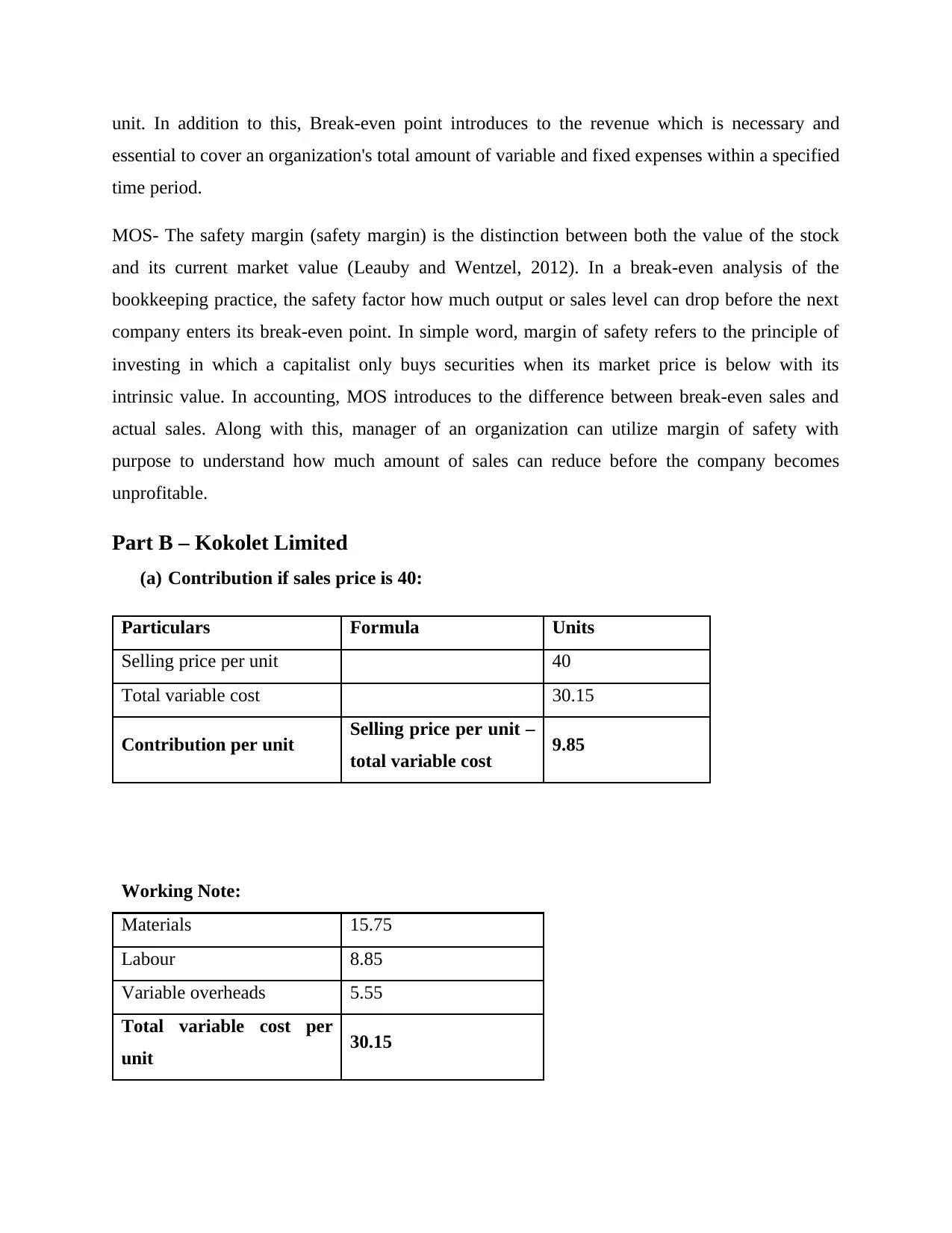
unit. In addition to this, Break-even point introduces to the revenue which is necessary and
essential to cover an organization's total amount of variable and fixed expenses within a specified
time period.
MOS- The safety margin (safety margin) is the distinction between both the value of the stock
and its current market value (Leauby and Wentzel, 2012). In a break-even analysis of the
bookkeeping practice, the safety factor how much output or sales level can drop before the next
company enters its break-even point. In simple word, margin of safety refers to the principle of
investing in which a capitalist only buys securities when its market price is below with its
intrinsic value. In accounting, MOS introduces to the difference between break-even sales and
actual sales. Along with this, manager of an organization can utilize margin of safety with
purpose to understand how much amount of sales can reduce before the company becomes
unprofitable.
Part B – Kokolet Limited
(a) Contribution if sales price is 40:
Particulars Formula Units
Selling price per unit 40
Total variable cost 30.15
Contribution per unit Selling price per unit –
total variable cost 9.85
Working Note:
Materials 15.75
Labour 8.85
Variable overheads 5.55
Total variable cost per
unit 30.15
essential to cover an organization's total amount of variable and fixed expenses within a specified
time period.
MOS- The safety margin (safety margin) is the distinction between both the value of the stock
and its current market value (Leauby and Wentzel, 2012). In a break-even analysis of the
bookkeeping practice, the safety factor how much output or sales level can drop before the next
company enters its break-even point. In simple word, margin of safety refers to the principle of
investing in which a capitalist only buys securities when its market price is below with its
intrinsic value. In accounting, MOS introduces to the difference between break-even sales and
actual sales. Along with this, manager of an organization can utilize margin of safety with
purpose to understand how much amount of sales can reduce before the company becomes
unprofitable.
Part B – Kokolet Limited
(a) Contribution if sales price is 40:
Particulars Formula Units
Selling price per unit 40
Total variable cost 30.15
Contribution per unit Selling price per unit –
total variable cost 9.85
Working Note:
Materials 15.75
Labour 8.85
Variable overheads 5.55
Total variable cost per
unit 30.15
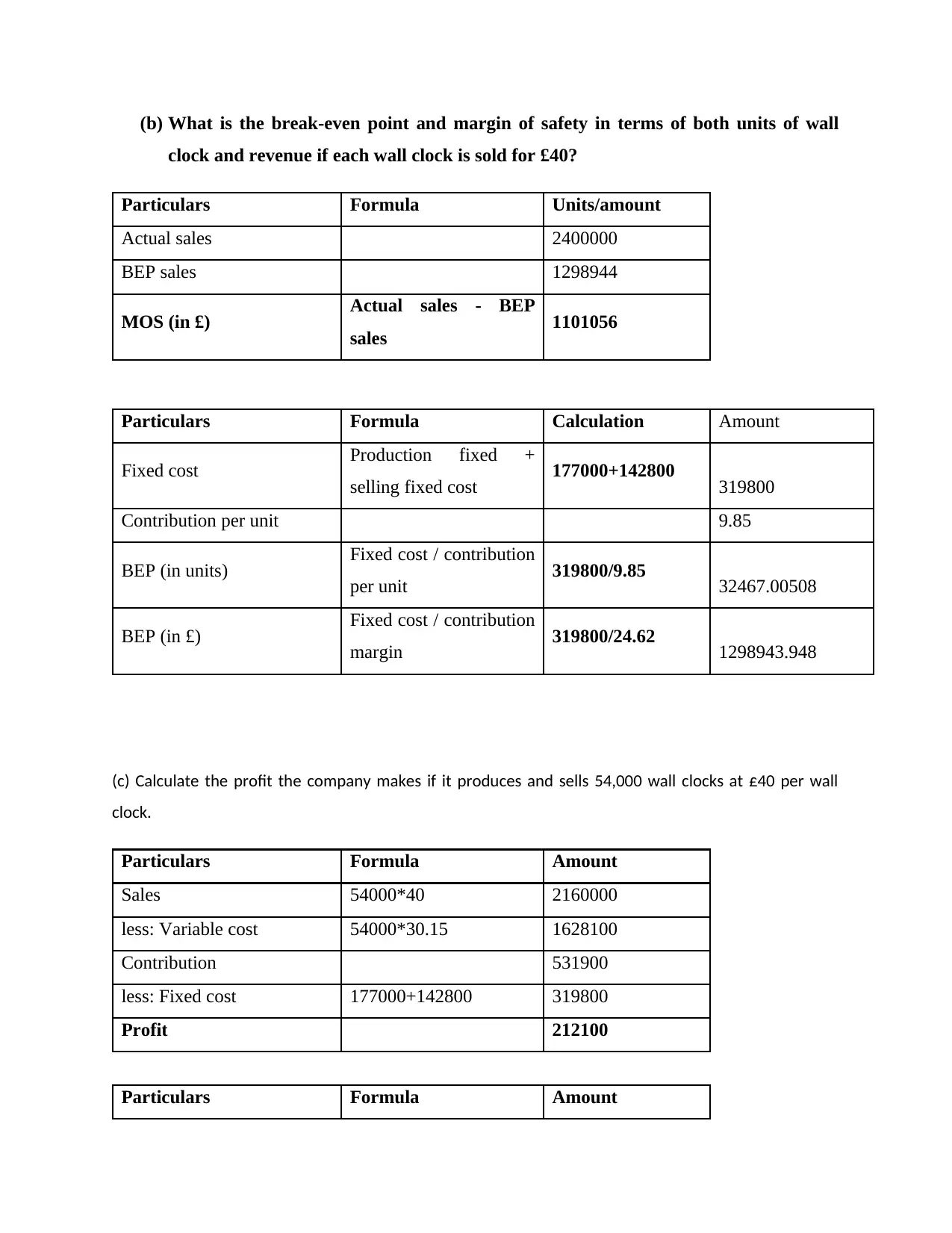
(b) What is the break-even point and margin of safety in terms of both units of wall
clock and revenue if each wall clock is sold for £40?
Particulars Formula Units/amount
Actual sales 2400000
BEP sales 1298944
MOS (in £) Actual sales - BEP
sales 1101056
Particulars Formula Calculation Amount
Fixed cost Production fixed +
selling fixed cost 177000+142800 319800
Contribution per unit 9.85
BEP (in units) Fixed cost / contribution
per unit 319800/9.85 32467.00508
BEP (in £) Fixed cost / contribution
margin 319800/24.62 1298943.948
(c) Calculate the profit the company makes if it produces and sells 54,000 wall clocks at £40 per wall
clock.
Particulars Formula Amount
Sales 54000*40 2160000
less: Variable cost 54000*30.15 1628100
Contribution 531900
less: Fixed cost 177000+142800 319800
Profit 212100
Particulars Formula Amount
clock and revenue if each wall clock is sold for £40?
Particulars Formula Units/amount
Actual sales 2400000
BEP sales 1298944
MOS (in £) Actual sales - BEP
sales 1101056
Particulars Formula Calculation Amount
Fixed cost Production fixed +
selling fixed cost 177000+142800 319800
Contribution per unit 9.85
BEP (in units) Fixed cost / contribution
per unit 319800/9.85 32467.00508
BEP (in £) Fixed cost / contribution
margin 319800/24.62 1298943.948
(c) Calculate the profit the company makes if it produces and sells 54,000 wall clocks at £40 per wall
clock.
Particulars Formula Amount
Sales 54000*40 2160000
less: Variable cost 54000*30.15 1628100
Contribution 531900
less: Fixed cost 177000+142800 319800
Profit 212100
Particulars Formula Amount
⊘ This is a preview!⊘
Do you want full access?
Subscribe today to unlock all pages.

Trusted by 1+ million students worldwide
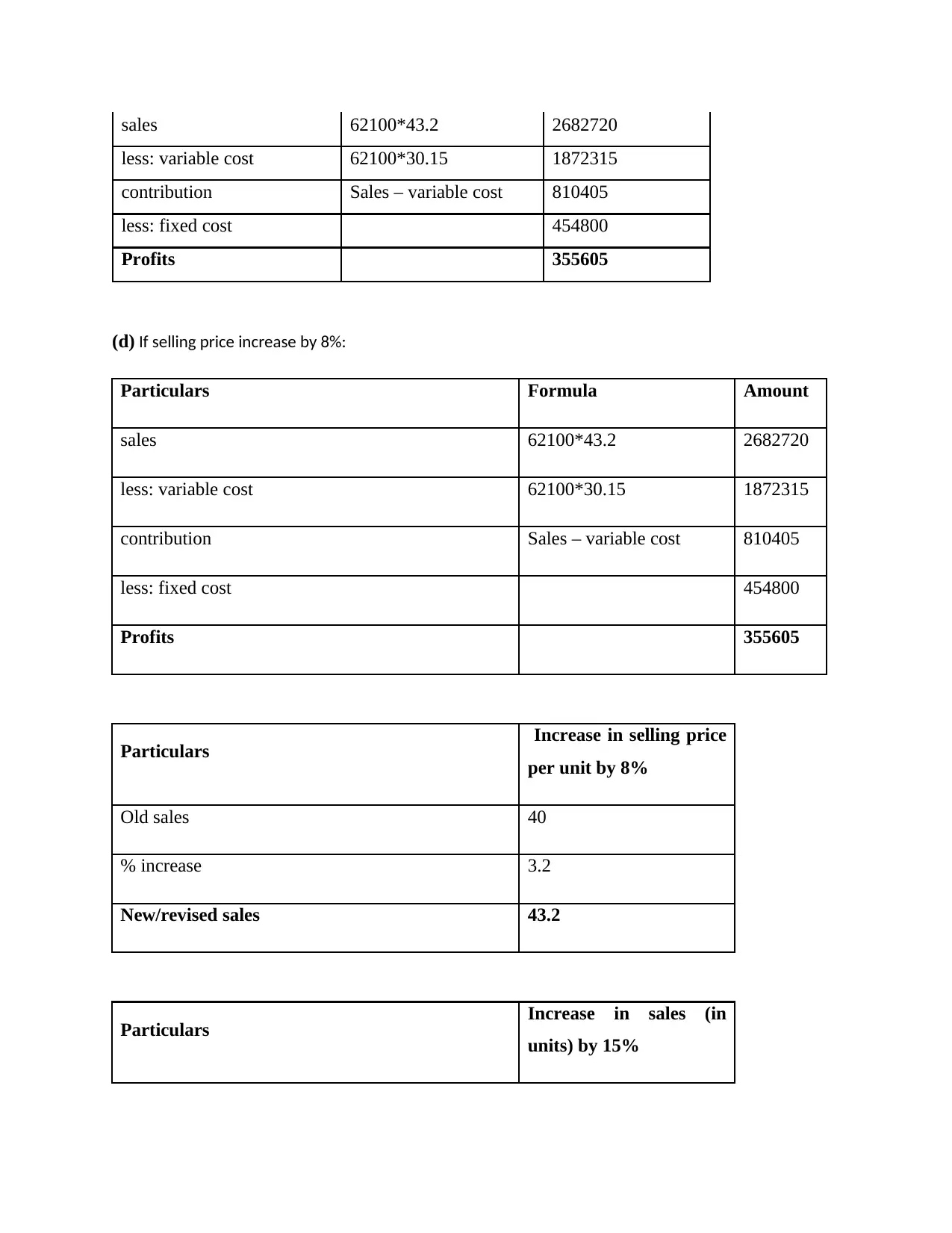
sales 62100*43.2 2682720
less: variable cost 62100*30.15 1872315
contribution Sales – variable cost 810405
less: fixed cost 454800
Profits 355605
(d) If selling price increase by 8%:
Particulars Formula Amount
sales 62100*43.2 2682720
less: variable cost 62100*30.15 1872315
contribution Sales – variable cost 810405
less: fixed cost 454800
Profits 355605
Particulars Increase in selling price
per unit by 8%
Old sales 40
% increase 3.2
New/revised sales 43.2
Particulars Increase in sales (in
units) by 15%
less: variable cost 62100*30.15 1872315
contribution Sales – variable cost 810405
less: fixed cost 454800
Profits 355605
(d) If selling price increase by 8%:
Particulars Formula Amount
sales 62100*43.2 2682720
less: variable cost 62100*30.15 1872315
contribution Sales – variable cost 810405
less: fixed cost 454800
Profits 355605
Particulars Increase in selling price
per unit by 8%
Old sales 40
% increase 3.2
New/revised sales 43.2
Particulars Increase in sales (in
units) by 15%
Paraphrase This Document
Need a fresh take? Get an instant paraphrase of this document with our AI Paraphraser
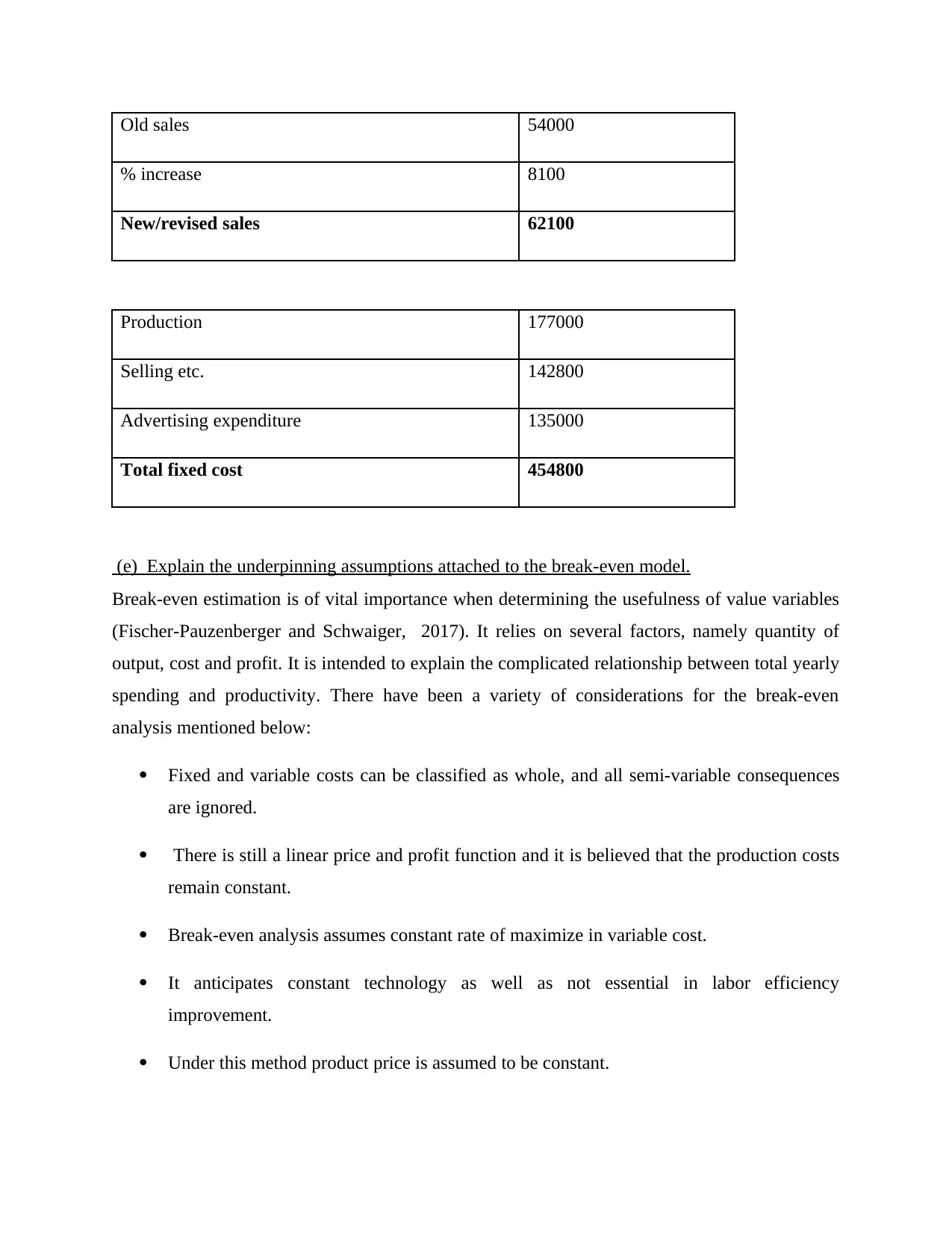
Old sales 54000
% increase 8100
New/revised sales 62100
Production 177000
Selling etc. 142800
Advertising expenditure 135000
Total fixed cost 454800
(e) Explain the underpinning assumptions attached to the break-even model.
Break-even estimation is of vital importance when determining the usefulness of value variables
(Fischer-Pauzenberger and Schwaiger, 2017). It relies on several factors, namely quantity of
output, cost and profit. It is intended to explain the complicated relationship between total yearly
spending and productivity. There have been a variety of considerations for the break-even
analysis mentioned below:
Fixed and variable costs can be classified as whole, and all semi-variable consequences
are ignored.
There is still a linear price and profit function and it is believed that the production costs
remain constant.
Break-even analysis assumes constant rate of maximize in variable cost.
It anticipates constant technology as well as not essential in labor efficiency
improvement.
Under this method product price is assumed to be constant.
% increase 8100
New/revised sales 62100
Production 177000
Selling etc. 142800
Advertising expenditure 135000
Total fixed cost 454800
(e) Explain the underpinning assumptions attached to the break-even model.
Break-even estimation is of vital importance when determining the usefulness of value variables
(Fischer-Pauzenberger and Schwaiger, 2017). It relies on several factors, namely quantity of
output, cost and profit. It is intended to explain the complicated relationship between total yearly
spending and productivity. There have been a variety of considerations for the break-even
analysis mentioned below:
Fixed and variable costs can be classified as whole, and all semi-variable consequences
are ignored.
There is still a linear price and profit function and it is believed that the production costs
remain constant.
Break-even analysis assumes constant rate of maximize in variable cost.
It anticipates constant technology as well as not essential in labor efficiency
improvement.
Under this method product price is assumed to be constant.
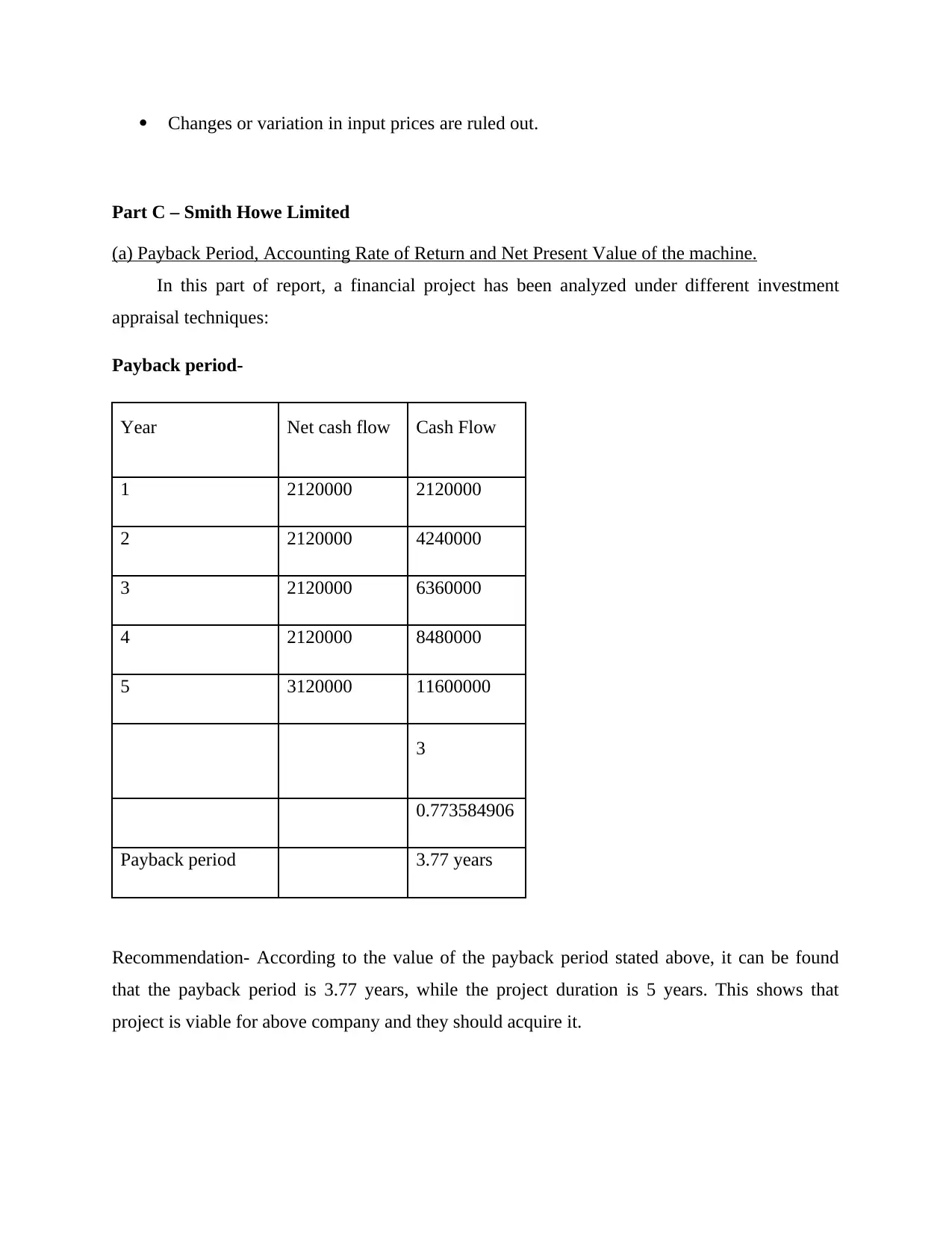
Changes or variation in input prices are ruled out.
Part C – Smith Howe Limited
(a) Payback Period, Accounting Rate of Return and Net Present Value of the machine.
In this part of report, a financial project has been analyzed under different investment
appraisal techniques:
Payback period-
Year Net cash flow Cash Flow
1 2120000 2120000
2 2120000 4240000
3 2120000 6360000
4 2120000 8480000
5 3120000 11600000
3
0.773584906
Payback period 3.77 years
Recommendation- According to the value of the payback period stated above, it can be found
that the payback period is 3.77 years, while the project duration is 5 years. This shows that
project is viable for above company and they should acquire it.
Part C – Smith Howe Limited
(a) Payback Period, Accounting Rate of Return and Net Present Value of the machine.
In this part of report, a financial project has been analyzed under different investment
appraisal techniques:
Payback period-
Year Net cash flow Cash Flow
1 2120000 2120000
2 2120000 4240000
3 2120000 6360000
4 2120000 8480000
5 3120000 11600000
3
0.773584906
Payback period 3.77 years
Recommendation- According to the value of the payback period stated above, it can be found
that the payback period is 3.77 years, while the project duration is 5 years. This shows that
project is viable for above company and they should acquire it.
⊘ This is a preview!⊘
Do you want full access?
Subscribe today to unlock all pages.

Trusted by 1+ million students worldwide
1 out of 21
Related Documents
Your All-in-One AI-Powered Toolkit for Academic Success.
+13062052269
info@desklib.com
Available 24*7 on WhatsApp / Email
![[object Object]](/_next/static/media/star-bottom.7253800d.svg)
Unlock your academic potential
Copyright © 2020–2025 A2Z Services. All Rights Reserved. Developed and managed by ZUCOL.




